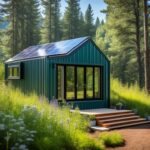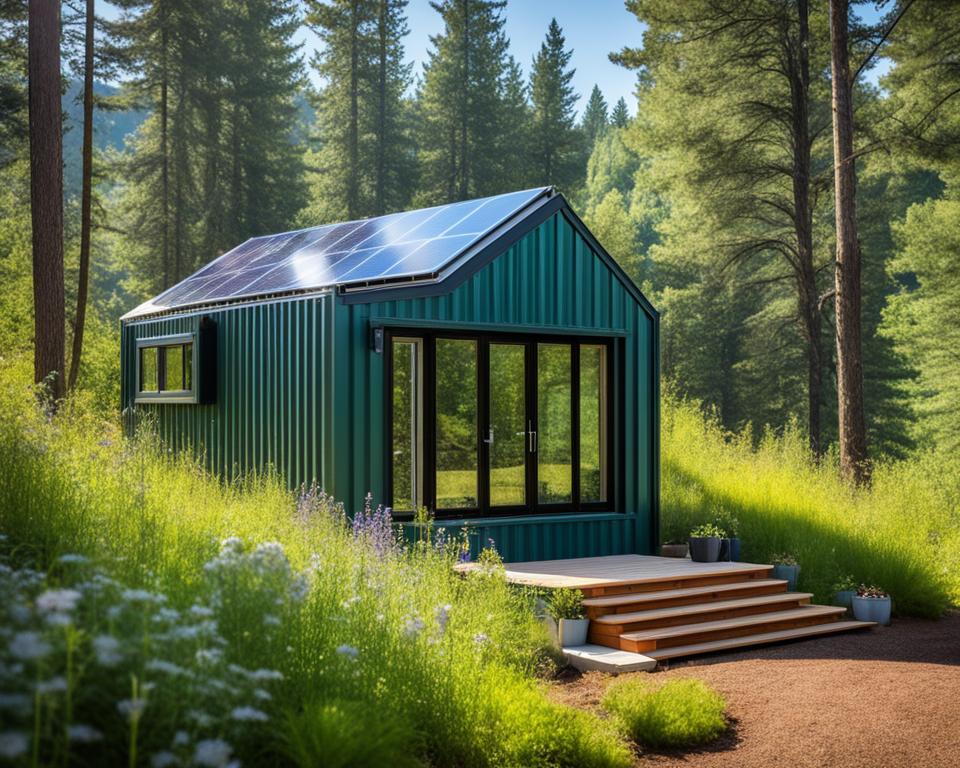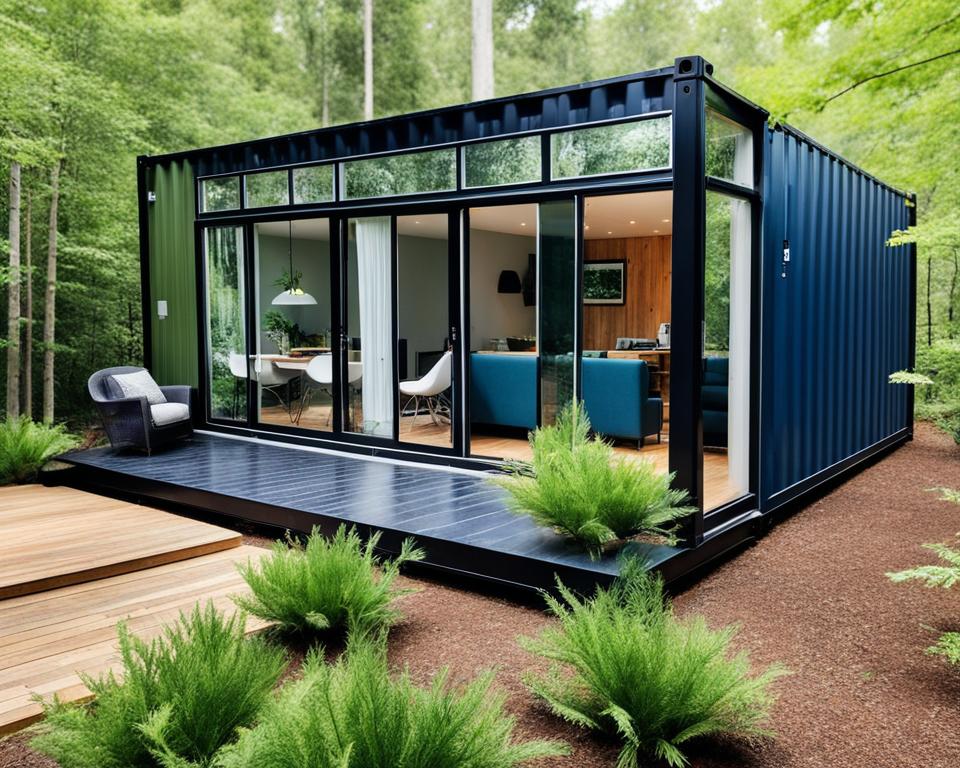The push for sustainable living is growing fast. Now, more than ever, we need eco-friendly and flexible housing options. Prefabricated folding container houses are changing how we see modular homes. They offer a green way to live that’s affordable, flexible, and good for the planet.
The C.Box folding container house is a great example. It’s made with materials that are good for the earth. These homes use space well, fitting 12 units in one 40FT container. They also cut down on waste and emissions, making them a top pick for those wanting to live sustainably.
Key Takeaways
- Folding container houses are an innovative solution for sustainable living.
- These modular homes offer high space optimization and can fit 12 sets in a single 40FT HQ container.
- Constructed with eco-friendly materials, folding container houses reduce environmental impact and construction waste.
- The modular design allows for customization, enabling residents to tailor their living spaces to their needs.
- Products like the C.Box folding container house signify the practicality of green lifestyle and housing solutions.
Introduction to Folding Container Houses
Folding container houses are changing the way we think about living spaces. They offer a new kind of home that is efficient, sustainable, and flexible. These homes use shipping containers but are easier to put together and can be customized.
Recently, these houses were in the spotlight at the FIFA World Cup 2022. They were used as a quick and practical way to provide housing. For example, the Changsha Fangcai Hospital project used them to set up 2,450 beds fast, up to 3 to 5 times quicker than usual.
These houses can be taken apart and put back together without creating waste. This makes them a green choice. They are built with strong materials, like Caigong steel foam board, which ensures they last a long time.
Setting up these houses is quick, taking just four minutes for a complete setup. Only three people are needed to put 800 square meters of these houses together in a day. These houses can last more than 10 to 20 years, depending on how they are designed.
| Project | Data |
|---|---|
| Installation Time | 4 minutes per set |
| Labor Requirement | Three people for 800 sq meters per day |
| Life Span | 10-20 years |
| Wall Thickness | 33mm |
| Roof Thickness | 50mm |
Using these prefabricated structures for living spaces is both practical and modern. They can be used for many things, like offices, dorms, and warehouses. This shows how versatile and useful these folding container houses are.
Sustainability Advantages of Folding Container Houses
Folding container houses offer many benefits for eco-friendly building. They are designed to be efficient and support a green building approach. This is key for the circular economy.
Using Recycled Materials
Folding container houses use recycled building materials. They take old shipping containers and turn them into homes. This reduces waste and saves resources.
It also lowers the environmental impact of building. Using recycled materials fits well with the circular economy. It helps create a more sustainable future.
Low Environmental Impact
Building folding container houses has a lower environmental impact than traditional homes. They need less energy and resources to build. This makes them eco-friendly.
These homes also have a lower carbon footprint. They use sustainable materials and are designed to save energy. This helps reduce greenhouse gases and supports global sustainability goals.
They are also built 50% faster than traditional buildings. This means less disruption to the environment.
Also, these homes are more energy-efficient. They can save homeowners up to 15% on heating and cooling costs. This shows their commitment to green building and makes them a great choice for eco-conscious people.
| Advantage | Statistics |
|---|---|
| Waste Reduction | 25% decrease compared to traditional housing |
| Reduced Construction Costs | Up to 30% lower |
| Lower Carbon Footprint | Significantly lower due to recycled materials and energy-efficient design |
| Faster Assembly | 50% faster than traditional construction |
| Lower Transportation Costs | Up to 40% lower |
| Energy Efficiency | 15% decrease in heating and cooling expenses |
Cost-Effectiveness of Folding Container Houses
Folding container houses are a great deal compared to traditional homes. They cost between $10,000 and $50,000. This makes them affordable for many people. The price depends on size, materials, custom features, and location.
These houses are cheaper because of efficient manufacturing and lower labor costs. Their design and assembly make them more affordable than traditional homes. Plus, they offer a good solution for affordable living.
Many lenders offer financing for these houses similar to regular home loans. This makes them even more appealing to buyers.
These houses are also good for the planet. Using shipping containers reduces waste and supports recycling. They are durable and can be reused, cutting down on the need for new materials. This saves money and helps the environment.
For those on a tight budget or needing temporary housing, these houses are a smart choice. They offer quality and sustainability without breaking the bank. The demand for these houses is growing, making them a key player in the housing market.
| Cost Parameter | Folding Container Houses | Traditional Homes |
|---|---|---|
| Price Range | $10,000 – $50,000 | $150,000 – $500,000+ |
| Material Costs | Low | High |
| Labor Costs | Reduced | High |
| Construction Time | Shorter | Longer |
Versatility and Customization Options
Folding container houses are perfect for those who want adaptable housing. They come in many styles, from simple studios to big complexes. These structures fit any need and place, making living space efficient and tailored to you.
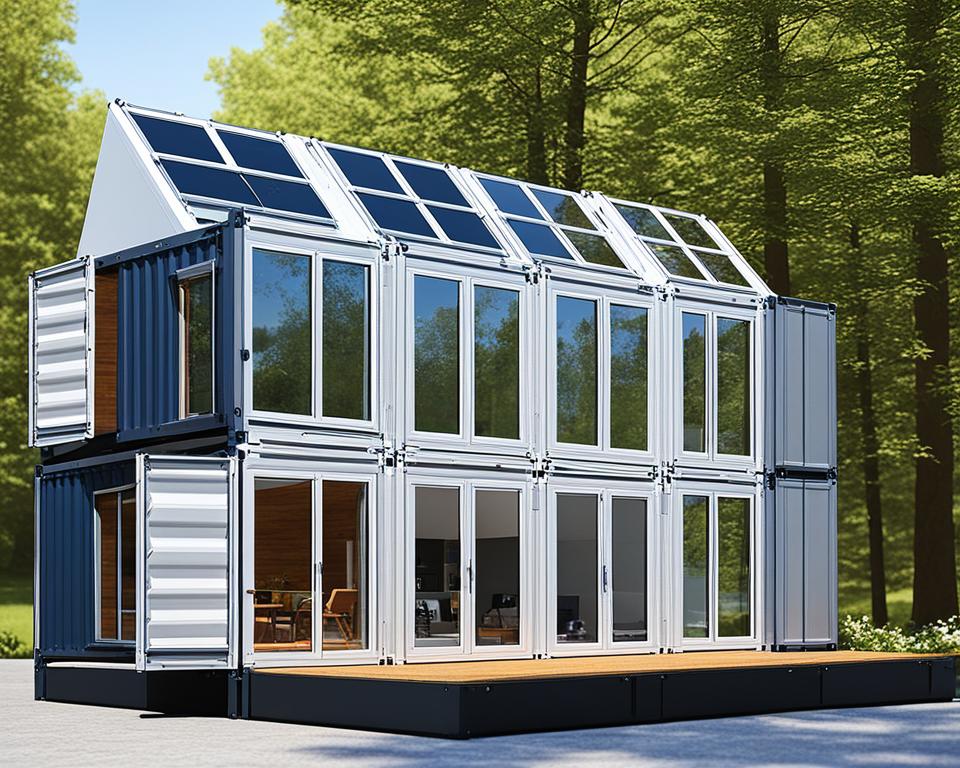
Wide Range of Applications
Custom-built containers are not just for homes. They’re great for temporary shelters, mobile offices, dorms, and emergency shelters. They’re built off-site and put together quickly, making them ideal for different uses.
This means they can be moved easily for travel or emergencies. It’s a big plus for those who need a structure that can change with their needs.
Design Flexibility
Folding container houses let you design your space your way. You can add modular furniture, smart tech, and save energy. This means you can make your home truly yours, with unique layouts and finishes.
New tech and materials keep making these options even better. Now, you can add smart home features and expand your space easily.
Mobility and Ease of Transportation
Folding container homes are great as transportable homes and relocatable housing. They are super light, making them easy to move around in cities like Las Vegas. These homes can be put together and taken apart quickly, which is great for changing needs without a lot of work.
These portable structures are made from recycled shipping containers. They are eco-friendly and strong. They work well on different land types, from city to countryside. People who move a lot find these homes perfect for their lifestyle.
The living spaces in these easy-to-move containers are perfect for those who like simple living. They can be moved easily thanks to wheels or skid mounts. They also save money on moving and fit into tight spots in cities.
They stay comfortable in different weather thanks to modern insulation. Solar panels help save on energy costs. The inside is light and easy to change, making them very flexible. Talking to architects or designers can make these homes even better for your needs, offering new ways to live small.
| Feature | Benefit |
|---|---|
| Lightweight Materials | Easy Transport |
| Modular Design | Quick Assembly & Disassembly |
| Wheels/Skid Mounts | Facilitates Movement |
| Collapsible Structures | Reduced Logistics Costs |
| Eco-Friendly Features | Lower Carbon Footprint |
Rapid Assembly and Deployment
Foldable container houses are changing the way we build things. They are fast and efficient. They are great for emergency shelters and temporary homes.
Quick Set-Up
These homes can be set up in just 10 minutes by two people. This is super fast for when you need a place to live right away. Plus, they can be put on any flat surface in less than five minutes.
Minimal Labor Requirements
Building these houses doesn’t need a lot of workers. They are much easier than traditional buildings. This means they can be built faster and cost less money.
Also, they can be put together in hard-to-reach places easily. This makes them perfect for many situations.
In short, foldable container houses are great for fast building and quick setup. They are perfect for urgent housing needs and many other uses.
Durability and Structural Integrity
Folding container houses are known for their toughness and strong build. They can handle tough weather and last a long time. This makes them perfect for many places.
Resilience to Harsh Conditions
These homes are very strong and can stand up to bad weather. They use Corten steel for strength and to resist rust. Also, insulated panels keep energy in and out, making them weatherproof.
They also have outer coverings like corrugated steel and aluminum. These protect the house and keep it strong over time. This careful design means these homes are a smart choice for the long haul.
Long-Lasting Materials
The right materials are key to making these homes last. They use strong wood and laminate for floors, and steel for doors and windows. This makes them safe and keeps the inside warm or cool.
Roofs are covered with corrugated metal and asphalt shingles to fight the weather. Inside, walls are made of gypsum board and plywood for looks and function. These materials and methods make the homes last 20 to 30 years or more with care.
Keeping up with maintenance, like checking for rust and fixing parts, helps them last longer. Good design also spreads the weight evenly. This stops weak spots and keeps the house strong, even when moved often.
Reducing Transportation Emissions
Foldable shipping containers are great for low-emission transport. Navlandis uses Zbox containers and has cut emissions by over 30% on some sea routes. This helps meet the International Maritime Organization’s goal to reduce emissions by 50% by 2050.
These containers also help reduce the carbon footprint by using space more efficiently. When empty and folded, they take up 80% less space than traditional containers. This means fewer trips and less pollution. For example, a route from Nanjing, China, to Toledo, Spain, saw emissions drop by 32% and costs by 17% with Zbox containers.
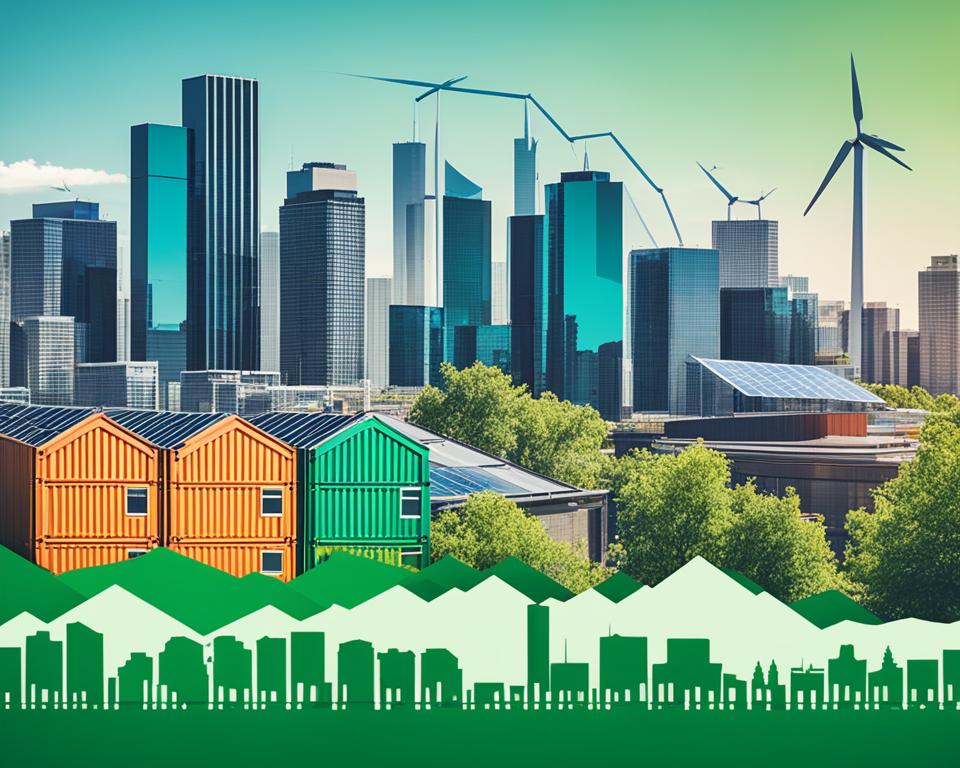
Continest is also working on eco-friendly logistics. They’re cutting emissions when moving their units. This helps lower the carbon footprint and supports global sustainability goals. Companies like GenFlat are also making a difference by cutting repositioning costs by up to 75% and reducing fuel use and traffic.
Zbox containers from Marguisa have cut logistics costs by up to 40% and transit time by 33%. This shows their efficiency and role in green shipment. With plans to add 300 more Zbox containers, the focus on sustainability in logistics is growing.
These innovations could change the shipping industry for the better. They make it more environmentally friendly. The push for eco-friendly logistics and low-emission transport could lead to a greener future in global trade.
Innovative Design Features
Foldable container houses are changing the way we live with their smart design. They mix modular construction, sustainable architecture, and energy conservation ideas. This creates a unique and efficient living space.
Removable Wall Panels
One key feature is the removable wall panels. These panels let you change the space to fit your needs. Want a bigger living room or a larger kitchen? Just move the panels. With modular construction, these homes can change with your life.
Energy-Efficient Design
These houses are built to save energy. They have solar panels, systems for collecting rainwater, and efficient insulation. These features cut down on energy use and bills, making living eco-friendly. Using sustainable architecture, they use renewable energy for heating, cooling, and water, helping save the planet.
Companies like DXH Container Homes are leading the way. They show how foldable container houses are affordable, strong, and easy to set up. This makes them a great choice for housing.
Let’s look at these features in detail:
| Feature | Benefit |
|---|---|
| Removable Wall Panels | Customizable space configurations |
| Energy-Efficient Insulation | Reduces utility costs |
| Solar Panels | Minimizes energy consumption |
| Rainwater Collection Systems | Promotes eco-friendly water usage |
These design features make foldable container houses a smart choice. They are affordable, quick to set up, and support sustainable living.
Applications in Urban and Rural Settings
Folding container houses are a new solution for both city and countryside living. They are perfect for places where land is scarce and prices are high. These homes are affordable, easy to build, and can move, making them key for urban development and rural living.
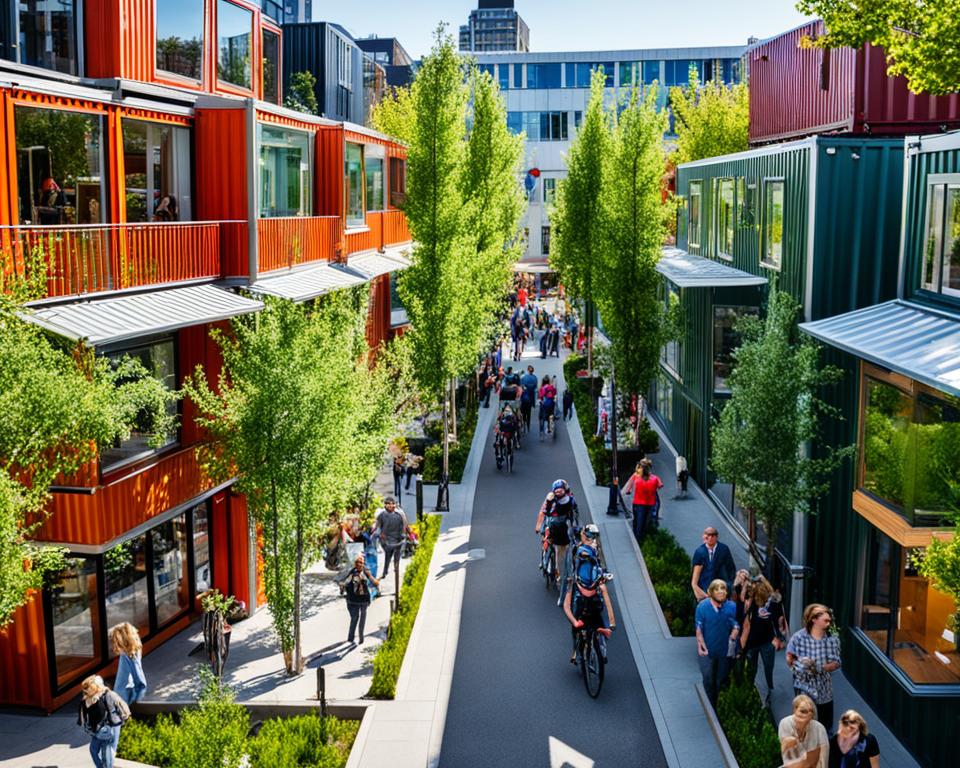
In cities like London and Amsterdam, container homes are popular for their small size and smart use of space. They help with community infrastructure in tight spots, making city living efficient. These homes are not just for living; they also work as cafes, restaurants, storage, and mobile offices.
In remote areas, container houses are adaptable and sustainable. They are a strong, affordable, and green choice for those wanting a simple life in the countryside. More and more, rural cabins in far-off places are using container designs.
“Insta-houses, constructed from containers, can include up to 2,000 square feet of living space at a cost of under $200,000,” showcasing cost-effectiveness.
Container houses are great for emergency and temporary housing because they are easy to set up and move. They help quickly in crisis situations, giving safe homes to those in need. This makes them a key part of disaster relief and humanitarian work.
| Application | Details |
|---|---|
| Urban Development | Compact footprint, multi-functional spaces, vertical expansion |
| Rural Living | Adaptability, eco-friendly materials, off-grid capabilities |
| Emergency Shelters | Rapid deployment, secure living spaces, cost-effective |
| Community Infrastructure | Support for cafes, restaurants, mobile offices, and storage units |
These homes are changing the look of cities and countryside alike. They show how folding container houses can meet many community needs. They prove to be innovative and green ways to live.
Case Studies and Success Stories
Looking at real-world examples of folding container homes shows their wide use and benefits. They are used for emergency shelters and unique business needs. These stories are both encouraging and teach us a lot.
Emergency Housing Solutions
One key success story is how these homes help in emergencies. They provide fast shelter during natural disasters or crises. For example, Maui’s foldable container city is a great example. It’s a strong, quick way to house people in need.
These homes can be ready for living in a day and fully set up in a week. This makes them perfect for disaster relief. They also use eco-friendly materials, which is good for the planet.
Commercial and Event Use
Folding container homes are also great for business and events. Companies and event planners like them because they save money and can be customized. For instance, they can be used as pop-up shops, cafes, or booths at festivals.
They are made of corten steel, which means they last a long time. This makes them a good choice for both short-term and long-term use. They work well in cities for events or in the countryside for seasonal activities.
These case studies show how popular container homes are in different areas. They prove to be effective, affordable, and support sustainable living.
Future of Folding Container Houses
The future of folding container houses looks bright and full of promise. As we move towards sustainable living, the need for new housing options grows. Folding container houses lead the way with their smart design and efficient use of resources.
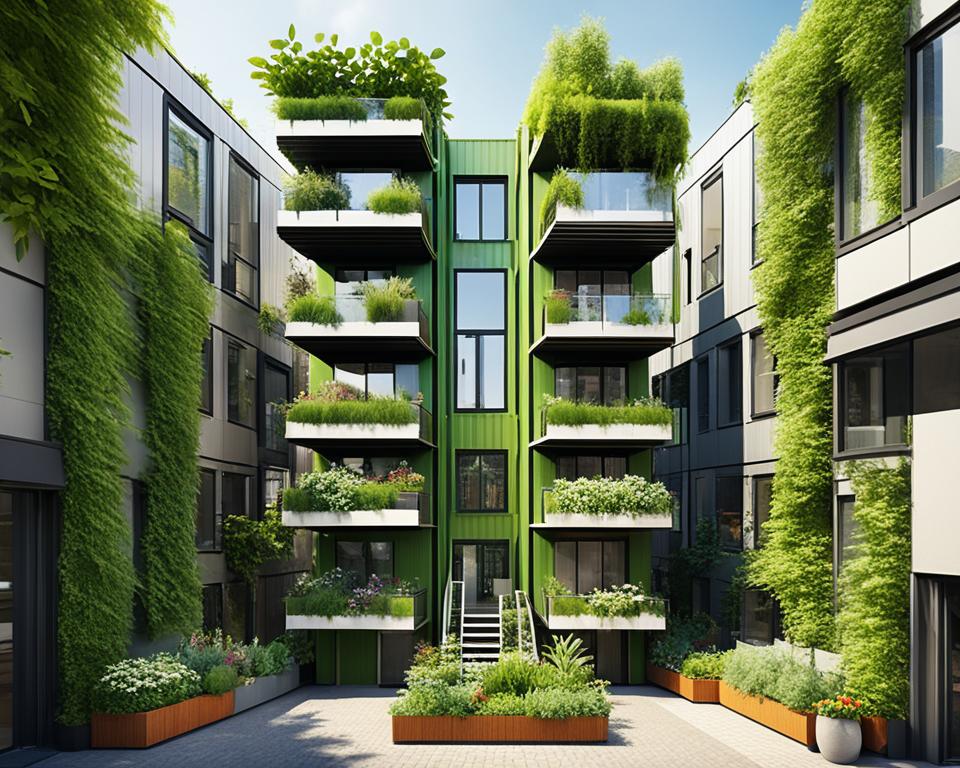
Technological Advancements
Advances in prefabrication technology have made folding container houses more popular. New materials and building methods have made them stronger and more efficient. Companies like Anderco, IQ Container Homes, and HONOMOBO are at the forefront, exploring new possibilities for these houses.
Growing Demand for Sustainable Living
Folding container houses are ideal for sustainable living. They help reduce waste and save resources, fitting perfectly with eco-friendly building goals. Projects like Community First! Village in Austin and Container City II in London show how these homes can be practical and scalable.
| Project | Location | Application |
|---|---|---|
| Community First! Village | Austin, Texas, USA | Affordable Housing |
| Container City II | London, UK | Mixed-Use Development |
| Vanderbilt Student Housing | Tennessee, USA | University Dormitories |
More people are choosing modern, sustainable living options, making folding container houses more popular. Governments and communities see their value, and these homes are becoming more widespread. The future looks promising, with folding container houses set to play a big role in solving housing needs in a sustainable way.
Conclusion
Folding container houses are a big step forward in sustainable housing innovations. They mix eco-friendly features with useful benefits. These homes are now more popular for short-term stays, offices, and places for tourists. They are versatile and can be customized to fit different needs.
These homes use light steel frames and sandwich panels for better strength and insulation. This makes them a top choice for those looking for eco-friendly living spaces.
Thanks to new technology and manufacturing methods, these homes are affordable and easy to put together. They have a special design that makes them quick to assemble and use less labor. This cuts down on costs and time.
These homes also support green living by using recycled shipping containers and saving energy. This helps reduce energy use and carbon emissions.
The future of modular homes looks bright, with ongoing improvements aimed at meeting the need for sustainable living. Companies like ACE Container lead the way with 14 years of experience. They offer custom designs and finishes that last a long time. Folding container houses can move easily and fit into both city and country settings.
For more details on this new way of building homes, check out the benefits of folding container homes. They’re changing the future of housing solutions.
Source Links
- Folding Container House | China Famous Folding House,Foldable House Factory
- Folding Container House for Sale: A Modern Solution for Sustainable Living – Zhenxiang
- Leading Sustainable Foldable Container House For Fast Assembly Suppliers,Manufacturers
- Folding Container House – An Overview
- Folding Container House For Modular Hospital | K-HOME
- Features and advantages of Folding Container House
- News – The Future of Sustainable Living: Prefabricated Folding Container Homes
- News – Advantages of Prefabricated Folding Container Houses: A Modern Solution for Sustainable Living
- Folding Container House Price: Affordable Living Redefined
- Portable and Cost-Effective The Advantages of Folding Container Houses
- Foldable Container House Market Size & Share Analysis – Industry Research Report – Growth Trends
- The Art of Foldable Living: Transforming Container Houses into Homes
- Revolutionizing Home Living: Exploring the Versatility of Custom Storage Container Homes – DXH
- [Hot Item] Folding Storage Container House Folding House Container Home
- Why Are Container Homes in Las Vegas Becoming Popular?
- Folding Container House
- Foldable Container House – Shipping Container
- Do you know folding container house
- Temporary disaster relief shelters Prefab Folding Container House
- Fast Assembly Container House with Pointed Roof
- What are the materials used in the construction of a folding container house- Suzhou Watermeilun Integrated Housing Technology Co., Ltd.
- 10 Factors Affecting the Lifespan of Expandable Container House Company
- Expandable Container House – Leading custom container house manufacturer in China with 16 years experience
- Navlandis: Decarbonising the maritime industry
- All You Need to Know About Folding Container Homes
- Home – GenFlat
- Container House Design: Innovative Living Spaces
- Are Foldable Container Houses the Future of Sustainable Living?
- Revolutionizing Home Design: Foldable Container Homes – DXH
- News – Space-Saving Innovations: Lida Group’s Compact Container House Concepts
- Prebuilt Container Homes
- 8 Common Shipping Container Conversions
- Container Home Ideas: Innovative Designs
- Cash In on the Container Home Trend with Profitable Chinese Imports
- What’s Wrong With Shipping Container Housing? One Architect Says "Everything."
- Application of Foldable Container Houses in Disaster Emergencies https://www.grande-house.com/folding-container-house-the-future-of-sustainable-and-affordable-housing/
- Foldable Container House Market Size: Unlocking Emerging Growth Opportunities and Share Projections for 2024-2031
- Construct homes efficiently with foldable container houses
- Customized Folding Container House Suppliers Manufacturers in China
- Application of Foldable Container Houses in Disaster Emergencies https://www.grande-house.com/folding-container-house-a-revolutionary-approach-to-sustainable-housing/
- The Practicality of Folding Container Houses – ACE Container

